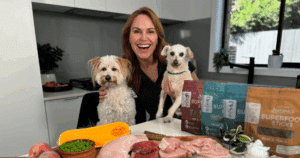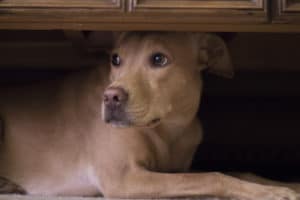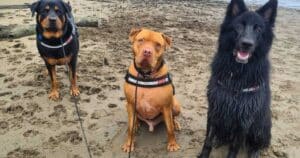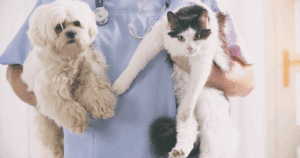
A dog’s Anterior Cruciate Ligament (ACL) is similar to the ACL in humans. The role of the ACL is to stabilise the knee joint and prevent it from twisting or overextending, therefore causing considerable lameness and pain if injured.
A dog with a cruciate ligament injury will often refuse to bear weight on the injured leg or may have a limp. Signs of a limp, no matter how mild, are a definite indication of pain.
ACL injuries in dogs are one of the most common orthopedic problems that I see as a vet and there are multiple causes for this ligament rupturing.
The major contributor is genetics. Conformation, hormonal imbalances, inflammation of the knee joint and obesity also play a role. After diagnosing an ACL rupture it is common to hear owners report that the dog suddenly jumped down from a height or turned awkwardly when running, yelped and then refused to walk on the leg.
Given the causes contributing to ACL rupture, it is very common for a patient to recover from surgical repair on one leg only to rupture the ACL in the other leg. This is why it is important to act promptly when lameness arises and have it treated correctly by your local veterinarian.
Your vet will perform a full physical examination including checking muscle tone, trigger points, gait and the location of joint pain and inflammation.
If your vet suspects an ACL rupture they may then take X-rays of the knee to investigate the extent of damage and to rule out other possible causes of lameness.
Whilst under general anesthetic, the stability or laxity of the knee joint is also fully assessed to help support the diagnosis. Arthroscopy is sometimes also performed to assess the degree of damage to the shock absorbing meniscal cartilage in the joint.
In almost all cases, surgery is required to repair the damage, return the leg to good working function and prevent ongoing debilitating joint disease. The type of surgery will depending on the degree of damage and size of the dog and is best determined by your veterinary surgeon.
The surgery is quite involved and your pet may remain in hospital overnight to assist with pain relief. After discharge you will required to follow a strict recovery program which initially limits exercise to lead restricted toilet outside and slowly increases over an 8 -12 week period.
I have personal experience with this process – not once but twice (yep Monty ruptured the other ACL 6 months later) and whilst it is rigorous, your efforts will definitely pay off with a happy and mobile pooch at the end.
Some Cruciate Ligament injuries may require physiotherapy to encourage use of the leg. Monty had a slow recovery post surgery but after he visited a veterinary physiotherapist and was prescribed water treadmill exercise, he was back in top condition!
Long term, I’ve kept Monty’s weight down and he is on a daily veterinary joint supplement to help maintain the health of his knee joints. I also restrict any crazy off lead movements at the park and encourage him to run after the ball in a straight line.
Surgery, physiotherapy and potential time off work can be costly. You may be looking at $5,000 to $6,000 by the end of it all. Taking out pet insurance for your dog or cat may help cover some of these costs if you have taken it out prior to the injury occurring and waiting periods no longer apply.
To help reduce the chances of a cruciate ligament injury occurring in your dog it helps to know if your dog’s breed, size or age is prone to ACL injuries and taking precautions.
These include:
Dr Melissa Meehan is a highly experienced and respected veterinary surgeon with over 14 years experience. Dr Melissa obtained her Members in Small Animal Medicine through examination in 2008 and now runs her own veterinary ophthalmology service.

Dog Treat Naturals Superfood Sticks



Poor gut health and dog behaviour issues



Get your paws on Lara Shannon’s best selling books ‘Eat, Play, Love (your dog) and World of Dogs.
Available in Australia, USA, UK and Canada.